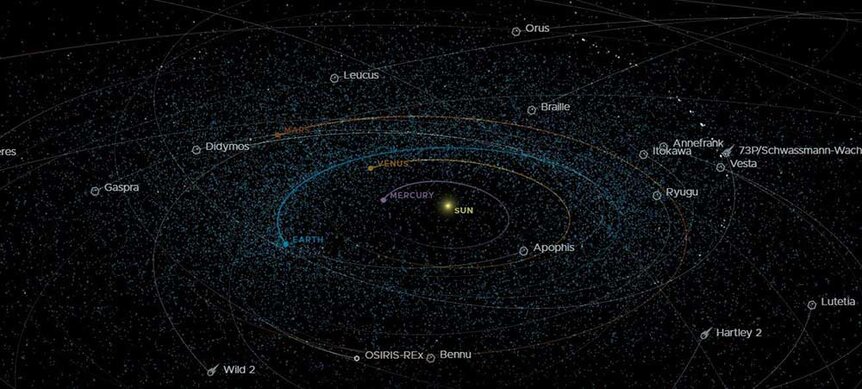Create a free profile to get unlimited access to exclusive videos, sweepstakes, and more!
Is a wave of asteroids headed toward Earth? Sort of.
It depends on what you mean by "wave."

The 2014 disaster movie Asteroid vs. Earth is streaming now on Peacock and provides all of the wackiness that only the end of the world can offer. The movie stars Tia Carrera (Wayne’s World, Lilo & Stitch) and Tim Russ (Star Trek) in what should more accurately be called Asteroids vs. Earth. You’ve seen movies with a single asteroid or maybe even a couple of them, but in Asteroid vs. Earth, our planet is on a collision course with a wave of impactors, coming in hot, all at the same time.
Moving all of them out of the way isn’t possible, so the heroes of our story do the only thing that has a chance of saving our species. They move the Earth, instead. We’re not prepared to dig into the logistics or the repercussions of moving an entire planet, but what about a wave of asteroids? It turns out, the Earth is like a serene beach along the cosmic coastline. We don’t (usually) get massive asteroid waves of the species-ending variety, but smaller waves gently lapping against our shores? Yeah, that happens all the time!
RELATED: New alien minerals found inside 15-ton fallen asteroid
NASA’s Jet Propulsion Laboratory (JPL) maintains an asteroid watch dashboard, which continually shows the next five objects passing within 4.6 million miles (7.5 million kilometers) of Earth. That’s the boundary inside of which an object more than 150 meters in diameter is considered a threat. So, we keep an eye on anything wandering around in that space. If close passes with asteroids are rare, we should expect those next five passes to stretch well into the future. However, at the time of this writing, all five slots are filled by asteroids passing in the next few days.
WHAT IS IN THIS WAVE OF ASTEROIDS?
The asteroid watch dashboard presents the next five objects in a simple table with a few quick facts. At a glance, you can see the name of the asteroid, the date and distance of its closest approach, and the size. That last bit is presented three ways: in feet, meters, and as a comparison to a common object. It's worth noting that information is continuosly updated as more observations come in. That means size, distance, and timing could fluctuate as we learn more. With that in mind, here's what we're looking at. First up is the asteroid 2023 GO2, which is roughly the size of a house, according to JPL. It’s about 57 feet (17 meters) across and will get as close as 572,000 miles, roughly twice the distance to the Moon.
After closest approach, it will be inside of Earth’s orbit until early June, after which point it will head back out into deep space. The next time it comes into the inner solar system is late 2025, but we’ll be on the other side of the Sun, at the time.
Right behind 2023 GO2, we have the asteroid 2023 HF, which is about the size of a bus (that’s 38 feet or 12 meters) and will get as close as 683,000 miles (1.1 million kilometers). It will cross Earth’s orbit and stay there until mid-July. Then it whips back out to beyond the orbit of Mars before coming back around. It will intersect the orbit of Earth again around the end of December 2024, but we won’t get back to the same point until late April. Because, in addition to helping you remember your mom’s birthday, calendars also represent where we are in our orbit.
The last two close approaches are both airplane-sized objects called 2023 HR1 and 2023 GV1. HR1 is 66 feet (20 meters) in diameter and will get as close as 1.56 million miles (2.51 million kilometers). Not to be outdone, GV1 is 72 feet (22 meters) wide, but will only get within 4.18 million miles (6.73 million kilometers) of Earth. GV1’s orbit is pretty unremarkable. It never crosses the orbit of Earth, instead stopping just short of our orbit at perihelion (the point along an orbit closest to the Sun) and stretches out to beyond the orbit of Mars at aphelion (the point along an orbit furthest from the Sun).
By contrast, HR1’s orbit is out of control. It stretches from halfway between Mercury and Venus to halfway between Earth and Mars, but it’s way off the plane of the ecliptic. Most of the time it’s way below (or above, depending on your perspective) the rest of the solar system. Its orbit almost perfectly intersects Earth’s orbit at one point. The next time Earth and HR1 will be in the same place at the same time won’t be until the 2050s.
Lastly, we have 2023 HK. At 43 feet (13 meters) it’s about the size of a house and was planning to get as close as 212,000 miles, sometime on April 20, 2023. After that, it will cross our orbit, moving toward the orbit of Venus. It will cross our orbit again on July 14, on its way back toward the outer solar system. That part of the trip is a bit longer. It will reach aphelion in the fall of 2024, blow a kiss to Jupiter as it passes, then turn back toward the inner solar system.
By the time you read this, it’s likely that one or several of these objects will already have passed, opening their slots for the next thing coming down the pipe. And there will be a next thing, there always is. Fortunately, these aren’t the sort of waves you need to worry about. Just don’t go to the space beach without your suit and you’ll be fine.
Catch Asteroid vs. Earth, streaming now on Peacock!



























